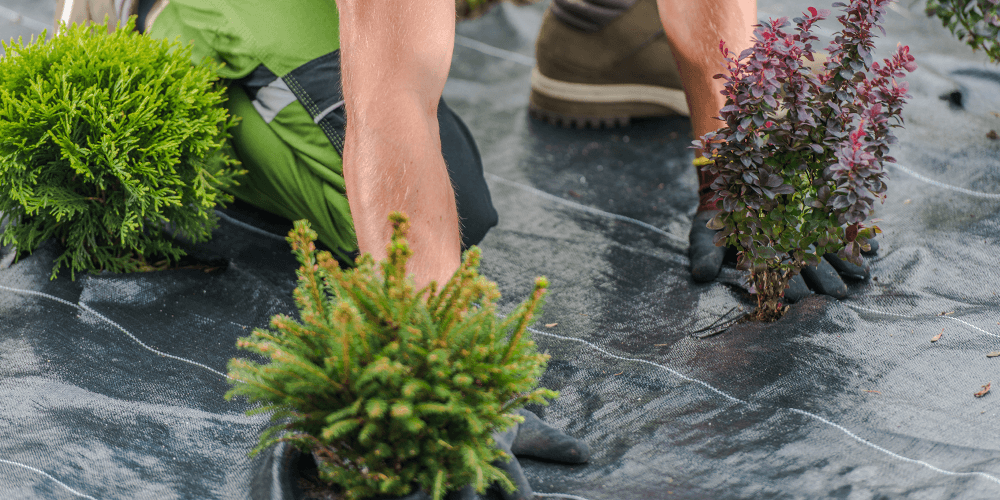Why you should use weed barrier cloth when planting flowers in agriculture is a question that many people are interested in. Because if you have never used this product, you will not fully understand its features. The article will help you answer the question of why you should use weed barrier cloth when planting flowers.
Weed barrier cloth - Why use it when planting flowers
Weed barrier cloth is a new product applied in agriculture to support the process of planting trees, especially flowers. This is a special type of cloth made from materials such as polyethylene, which is waterproof and UV-resistant. Using weed barrier cloth in the process of agriculture in general and planting flowers in particular will bring certain benefits.

Save time and effort:
Weed barrier cloth helps reduce the work of plowing, cutting grass, watering, and fertilizing, saving time and effort for flower growers.
Protect plants:
The barrier cloth can help retain soil moisture and protect plant roots from drying out, helping plants grow better. You can see the difference in the growth of different plants in the area that is covered with cloth and the area that is not.
Reduce pests and diseases:
The cloth can also reduce the development of harmful pests and insects, helping to keep plants healthy. It can also prevent the growth of harmful bacteria and fungi.
Increase productivity:
Using weed mat also helps increase crop productivity. Since it does not compete with grass or harmful insects, the plant will have more nutrients to grow and produce more flowers and fruits.
Save costs:
Using the mat also helps save costs for plowing, cutting grass, watering, and fertilizing. You can save a lot of money in the flower planting process and invest in other factors such as better flower seeds, fertilizer, and irrigation systems.
Enhance the uniformity of flower plants:
It can protect the soil around the flowers from competition with grass, helping the flowers have enough energy to grow stronger. The barrier cloth will prevent the growth of other grasses, keeping the area clean and beautiful. The roots of the flowers will not be cut back or compete with the roots of weeds, helping the flowers to have enough water and nutrients to grow. As a result, the flowers will be better able to resist diseases and pests and produce more and better flowers and fruits.
Protecting flowers from pests and insects:
The mat also helps to retain soil moisture, reducing the frequency of watering flowers. Because cover crops are capable of retaining moisture in the soil, water is easily retained inside the cover and does not evaporate quickly. This helps to save water and reduce watering costs for flower growers.

In addition, it also helps to prevent the growth of pests and insects that harm flowers. The cover keeps the soil and plant roots dry, making it difficult for pests and insects to develop and reproduce. With balanced control of soil moisture and nutrients, various types of pests and insects are reduced.
Increasing yield and flower quality:
When using cover crops, the soil around the flowers is protected from external factors such as sunlight, wind, and rain, helping to retain soil moisture and nutrients. This provides favorable conditions for the development of flowers and helps to increase yield and flower quality. When the soil is kept moist, flowers can absorb water and nutrients more efficiently, while also helping to avoid the problem of flowers drying out and dying. Additionally, reducing the frequency of watering also helps to save water resources and costs for flower growers.
Reducing costs and environmental impact:
When using cover crops, minimizing resource competition between flowers and weeds has helped reduce the need for fertilizers and pesticides. Because when weeds no longer compete with flowers for resources such as water, nutrients, light, and space, flowers are better able to grow and are less prone to disease. Therefore, flower growers do not need to use a lot of fertilizers and pesticides to protect their flowers. This not only helps to reduce costs for flower growers but also reduces the negative impact on the environment. Because reducing the amount of fertilizers and pesticides will minimize soil pollution and...
Reducing the need for manual labor:
You don't have to frequently weed or mow the lawn when using weed control fabric, which saves time and effort.
Preventing weed growth:
The weed control fabric impedes sunlight and retains soil moisture, preventing weed growth around the area where flowers are planted. This reduces competition between flowers and weeds for soil, water, and nutrients.
Protecting flowers from pests and diseases:
The weed control fabric helps retain soil moisture, reduces the frequency of watering, and prevents the growth of bacteria and fungi that can cause diseases in flowers.
Increasing productivity:
Using weed control fabric can increase productivity because flowers do not have to compete with weeds and are provided with sufficient resources to grow.
Maintaining the beauty of the garden:
Weed control fabric helps maintain the beauty of the garden by preventing the growth of wild weeds around flower species, which can disrupt the balance of nature.
However, when using weed control fabric, it is important to note that it can increase soil temperature and reduce air circulation. Therefore, you need to ensure that the soil remains well-ventilated and not too hot to ensure the development of the flowers.
So, you now have an answer to why you should use weed control fabric when planting flowers. I hope you have gained some practical information when using this product. For any further advice or information, please contact us at the address provided at the end of the article.
🌐 Address: Central Lake 1 Building, Aqua Bay, Ecopark, Phung Cong Commune, Van Giang District, Hung Yen Province
🌐 Website: https://epp.vn - https://eppvietnam.trustpass.alibaba.com
📲 +84 986 002 888 - sales@epp.vn



